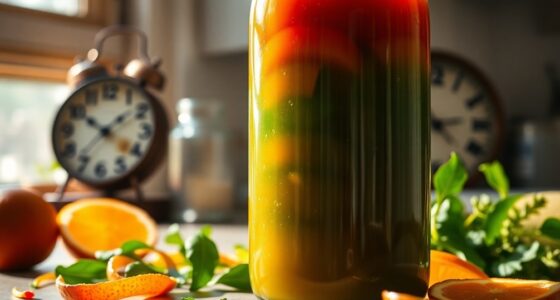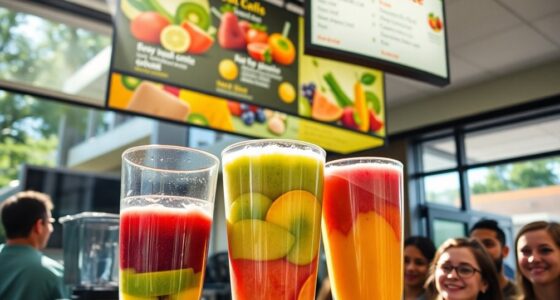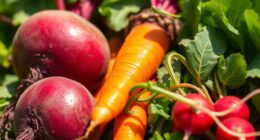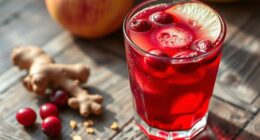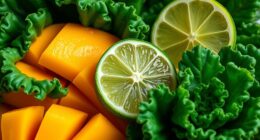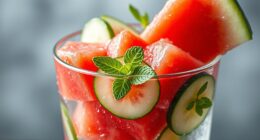Juicing with seasonal and local produce is your best bet for saving money and boosting your health! You’ll enjoy fresher flavors packed with nutrients, and since in-season items are cheaper, your grocery bill will drop. Plus, you’ll reduce waste and support local farmers. Prepping your ingredients ahead of time can streamline the process and maximize your juice yield. Stick with us to uncover more savvy tips for juicing and sustainability!
Key Takeaways
- Use seasonal and local produce for fresher flavors and lower costs, maximizing your health benefits and supporting local agriculture.
- Pre-portion ingredients in advance to save time and minimize waste, ensuring quick access to nutritious juices during busy weeks.
- Incorporate hydrating ingredients like cucumbers to increase juice yield and reduce overall produce usage, saving money and minimizing waste.
- Shop at farmers’ markets for discounts on unsold produce, allowing you to get fresh ingredients at a lower price.
- Utilize kitchen scraps, such as carrot tops and citrus peels, to enhance flavor and nutrients while reducing food waste.
The Benefits of Seasonal and Local Produce
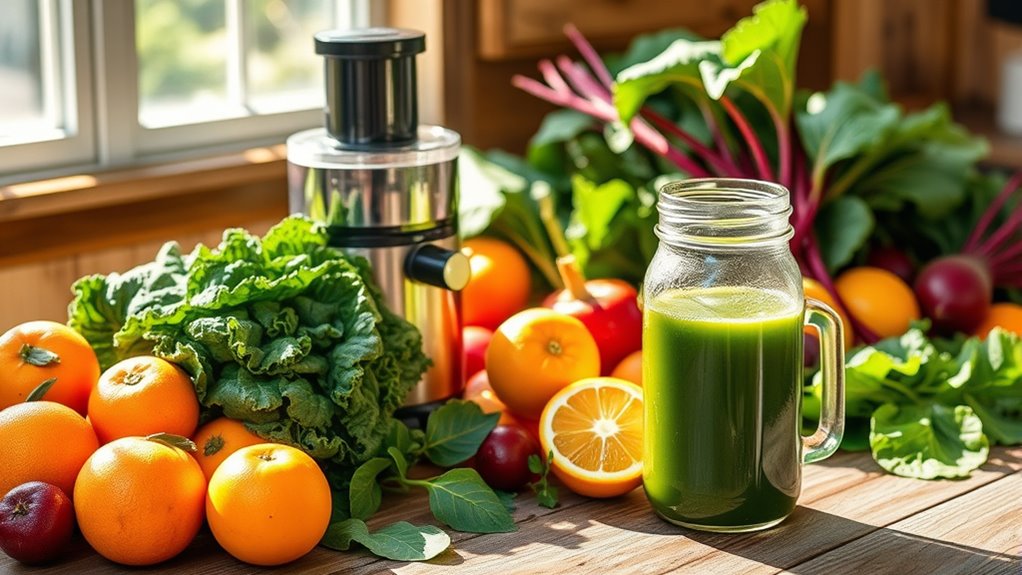
When you choose seasonal and local produce, you not only enjoy fresher flavors but also support your community and the environment.
Seasonal produce is often less expensive due to its higher availability, helping you save money while getting fruits and vegetables at their peak ripeness.
You’ll notice that locally sourced options have a lower carbon footprint since they don’t require long-distance transport, making them a more sustainable choice.
Plus, fresh, in-season produce is generally more nutrient-dense, offering greater health benefits compared to out-of-season imports that may lose nutrients during shipping. Additionally, incorporating unique homemade fruit juice recipes can further enhance your nutrition while maximizing the flavors of seasonal ingredients.
Planning Your Juicing Recipes
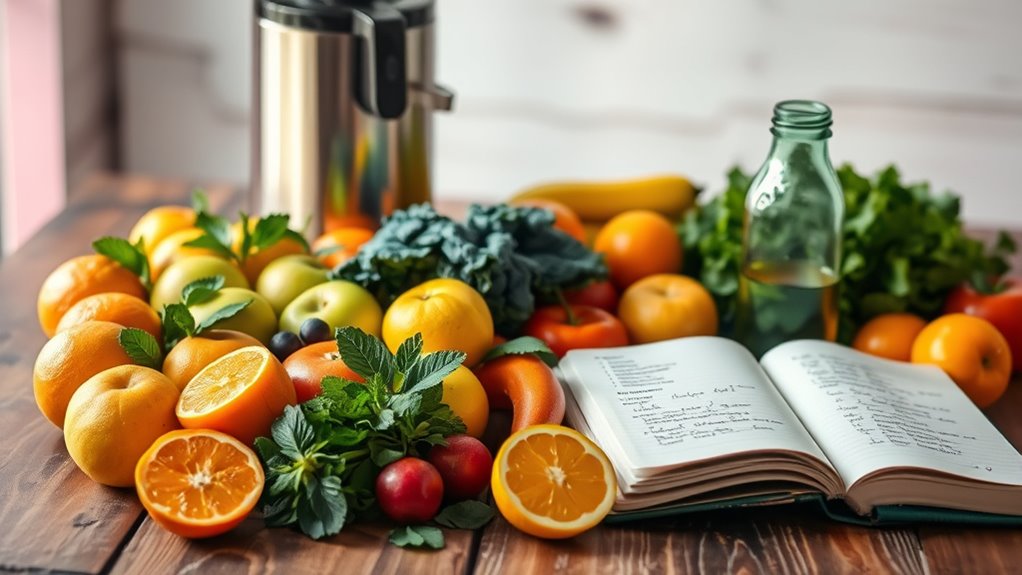
Planning your juicing recipes can save you time and money while ensuring you enjoy delicious flavors.
By selecting seasonal produce and prepping ingredients in advance, you’ll streamline your juicing routine and reduce waste.
Plus, experimenting with budget-friendly juice recipes lets you get creative without breaking the bank. Additionally, knowing the shelf life of freshly squeezed juices can help you make the most of your ingredients and minimize spoilage.
Ingredient Prepping Strategies
To make your juicing experience smoother and more enjoyable, prepping your ingredients in advance is essential. Here are some effective ingredient prepping strategies to save time and enhance your juicing routine:
- Pre-portion Ingredients: Compile fruits and vegetables into individual Ziploc bags or containers for quick access during busy weeks.
- Prevent Browning: Drizzle lemon juice on cut apples to keep them fresh and appealing for juicing.
- Plan Ahead: Decide on your juices in advance to avoid unnecessary purchases and only buy what you need.
- Utilize Leftovers: Use leftover fruits and vegetables, like half an apple or celery stalks, to boost volume and reduce waste.
Incorporating organic fruits and vegetables not only enhances flavor but also ensures you avoid pesticides.
With these tips, you’ll create a consistent juicing habit and enjoy the health benefits!
Seasonal Produce Selection
Incorporating seasonal produce into your juicing recipes can elevate both flavor and nutrition. When you choose fruits and vegetables in season, you not only enjoy fresher and tastier options, but you also save money, as they’re often cheaper when abundant.
For instance, buying watermelon in summer or squash in fall allows you to capitalize on their peak quality and lower prices. Seasonal produce is harvested at its ripest, providing more vitamins and minerals for your juices. Additionally, using fresh ingredients like celery, which is rich in vitamins A, C, and K, can enhance both the taste and health benefits of your juices.
Don’t forget to check local farmers markets for even better deals and to support community agriculture. This approach helps reduce food waste too, as you’ll be using ingredients that are fresh and plentiful, making your juicing experience both economical and healthy!
Budget-Friendly Juice Recipes
Budget-friendly juicing is all about smart ingredient choices and efficient planning. By preparing your juice recipes in advance, you save time and reduce waste, keeping your wallet happy.
Here are four tips to create budget-friendly juice recipes:
- Use in-season produce: They’re fresher and cheaper, giving you the best bang for your buck.
- Keep it simple: Try easy combinations like celery and apple or watermelon and lime to minimize costs.
- Incorporate scraps: Use leftover fruits and vegetable scraps to enhance flavor and nutrition while maximizing your ingredients.
- Pre-portion ingredients: Prepare bags of juicing ingredients for quick access, making it easier to stick to your juicing routine without overspending.
Additionally, consider adding essential oils to your juice for an extra boost of flavor and potential health benefits.
With these tips, you’ll enjoy delicious juices without breaking the bank!
Cost-Effective Shopping Strategies
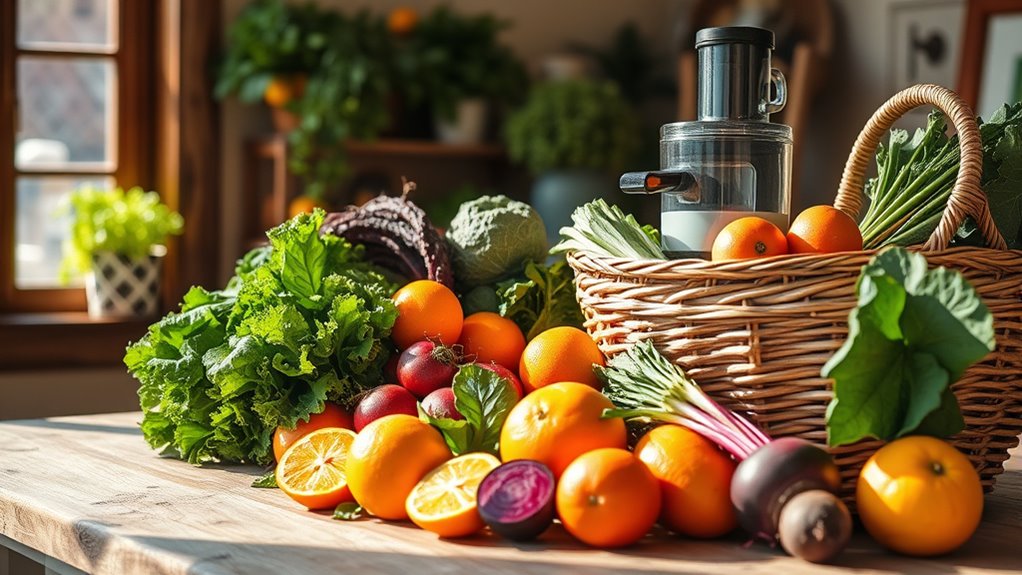
When it comes to juicing, smart shopping can make a big difference in your wallet. Focus on in-season produce, buy in bulk, and keep an eye out for discounts on slightly imperfect fruits and veggies. These cost-effective strategies will help you enjoy fresh juices without breaking the bank. Additionally, incorporating meal replacement juices into your routine can provide essential nutrients while reducing calorie intake.
Seasonal Produce Savings
By focusing on seasonal produce, you can considerably cut your grocery bills while enjoying fresher, tastier fruits and vegetables.
Here are some cost-effective shopping strategies to maximize your savings:
- Shop at local farmers’ markets: They often offer discounts on unsold produce, helping you save money and support local farmers.
- Plan your juices around in-season fruits: Items like cucumbers and watermelons are perfect for summer juicing and provide more juice for less cost.
- Buy in bulk during harvest seasons: Stock up on items such as apples and tomatoes when prices drop, ensuring you have them on hand for later.
- Embrace variety: Utilizing seasonal produce helps maximize nutrient intake while minimizing waste and save time in your meal prep.
Additionally, incorporating seasonal produce into your diet can lead to healthier breakfast alternatives, as many fruits and vegetables are perfect for smoothies or juices.
Bulk Purchase Benefits
Purchasing fruits and vegetables in bulk can considerably lower your grocery costs while ensuring you have plenty of fresh ingredients for your juicing needs. By focusing on seasonal produce, you’ll find that bulk purchases often come with lower prices per unit. Membership warehouses like Costco or Sam’s Club can be a goldmine for savings. Plus, utilizing leftover fruits and veggies helps you enhance juice volume while minimizing waste. Here’s a quick comparison of costs:
| Item | Bulk Price |
|---|---|
| Apples (10 lbs) | $10 |
| Carrots (5 lbs) | $5 |
| Spinach (2 lbs) | $4 |
| Oranges (8 lbs) | $12 |
Planning ahead helps you buy only what you need, letting you reduce costs effectively. Additionally, incorporating seasonal produce into your juicing routine can maximize both flavor and nutritional value.
Discounted Ingredient Finds
Finding discounted ingredients can greatly stretch your juicing budget, especially if you know where to look. Here are some savvy tips to help you score great deals on juicing ingredients:
- Check local grocery stores for discounted produce sections—bruised or oddly shaped items are still perfect for juicing.
- Visit farmers markets for ripe, seasonal fruits and veggies; prices often drop at the end of the day.
- Join membership warehouses like Costco or Sam’s Club for bulk buys—these savings can really add up.
- Use apps that track sales and markdowns on produce nearing sell-by dates, letting you plan your shopping trips efficiently and save time.
Additionally, consider whole foods as they not only provide better nutrition but can also be found at lower prices when purchased in bulk.
With these strategies, you’ll enjoy fresh juices without breaking the bank!
Maximizing Juice Yield With Water Content
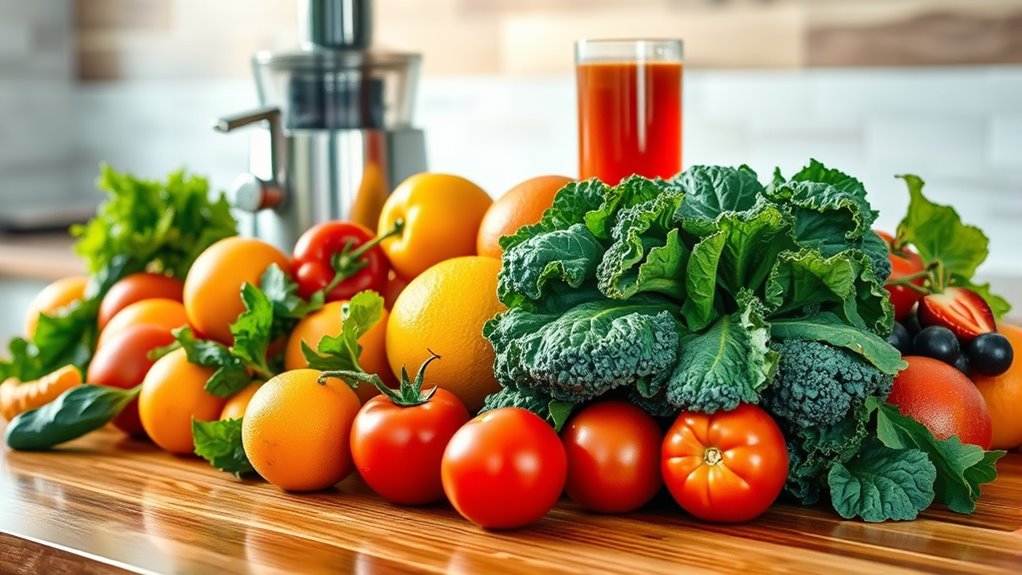
When you focus on high water content produce like cucumbers and tomatoes, you can greatly boost your juice yield.
These fruits and veggies can yield two to three times more juice compared to denser options like kale or carrots, making them cost-effective choices for your juicing recipes.
By incorporating more hydrating ingredients, you’ll use less overall produce, which helps save time and reduces food waste.
Incorporating hydrating ingredients not only saves time but also minimizes food waste.
Plus, diluting your juice with a bit of added water not only increases your volume but also cuts down on the cost per serving.
This approach allows you to enjoy a delicious, nutrient-rich juice while promoting your health without overspending. Additionally, consider the benefits of hydration and water intake for overall health, as staying hydrated is essential for optimal body function.
Embrace high-water content produce for a wallet-friendly juicing experience!
Utilizing Leftovers and Scraps
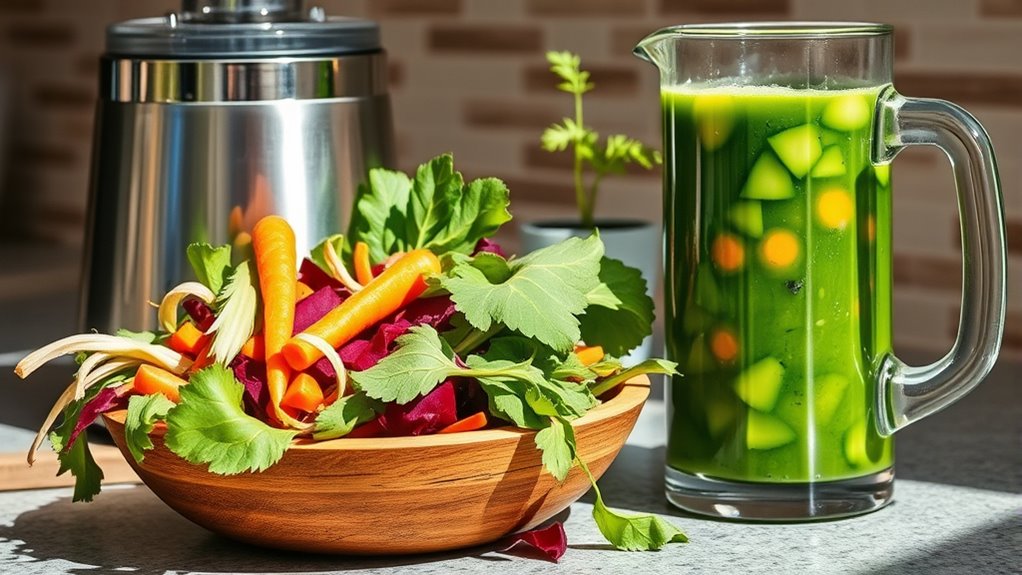
Maximizing your juicing potential doesn’t have to mean buying more produce; instead, you can get creative with leftovers and scraps. By utilizing scraps, you not only enhance your juice’s flavor but also save money.
Here are four ways to incorporate kitchen leftovers:
- Carrot tops – Adds a fresh, earthy taste and extra nutrients.
- Beet greens – Boosts your juice with antioxidants and vibrant color.
- Citrus peels – Infuses a zesty kick while packing in vitamins.
- Half an apple – Sweetens your juice and reduces waste.
Store these scraps in a freezer bag for easy access during your next juicing session.
This approach helps cut costs and contributes to sustainable food consumption!
Time-Saving Juicing Techniques
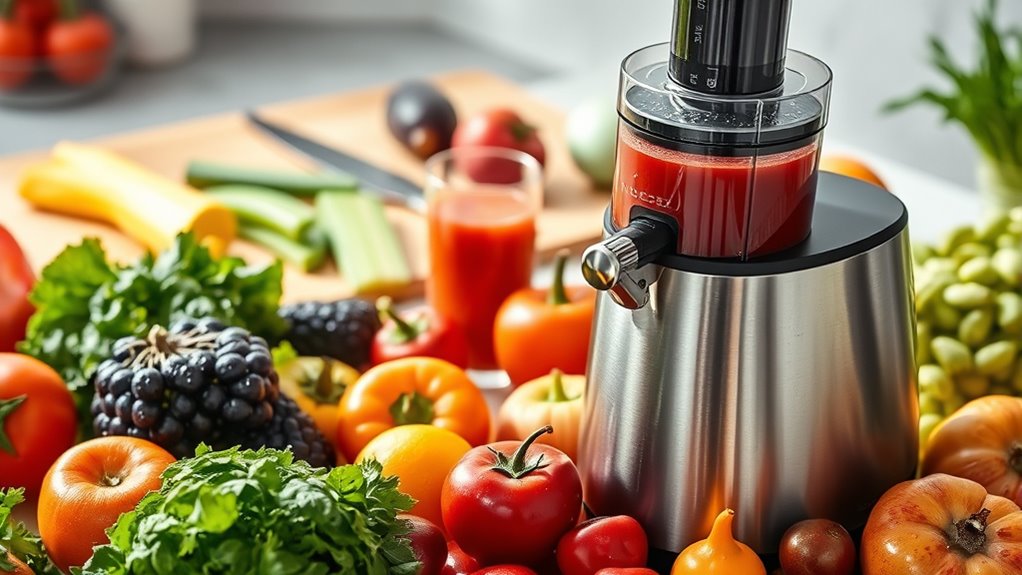
Juicing doesn’t have to be a time-consuming chore; with a few smart strategies, you can streamline the process and fit fresh juice into your busy lifestyle.
Start by prepping ingredients in advance—compile your fruits and veggies into Ziploc bags, cutting down on prep time during hectic weeks. Keep your juicer and accessories set up for quick access; this encourages you to make juice more often.
Consider prepping recipes like Green Detox Juice ahead of time for easy grabbing. Also, store leftover scraps in a freezer bag to boost juice volume without extra cost.
Finally, juice for the entire day at once to minimize cleanup and maximize efficiency, allowing you to enjoy fresh juice whenever you need it.
Budget-Friendly Juicing Recipes
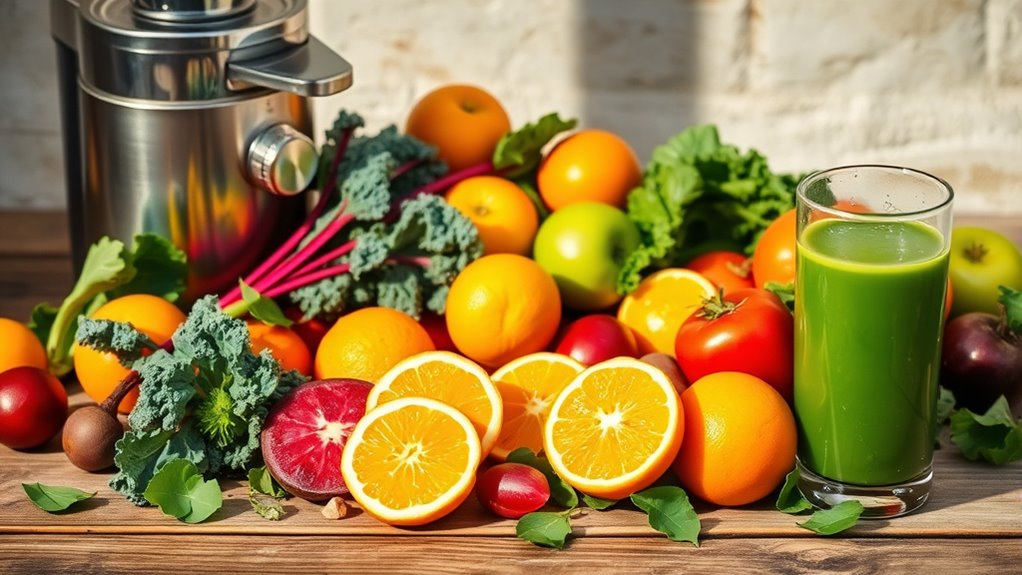
If you’re looking to enjoy delicious and nutritious juices without breaking the bank, there are plenty of budget-friendly recipes to try.
By using high-water content produce and seasonal fruits, you can create invigorating drinks while saving money. Here are four great ideas:
- Cucumber & Orange: Maximize juice yield with hydrating cucumbers and zesty oranges.
- Carrot & Apple: Combine these inexpensive ingredients for a sweet and nutrient-rich blend.
- Celery & Ginger: Experiment with this simple combo for a stimulating kick.
- Watermelon & Lime: Use leftover scraps from your watermelon for added flavor and volume.
These budget-friendly juice recipes not only cut costs but also help reduce waste by creatively using leftover scraps. Enjoy!
Growing Your Own Ingredients
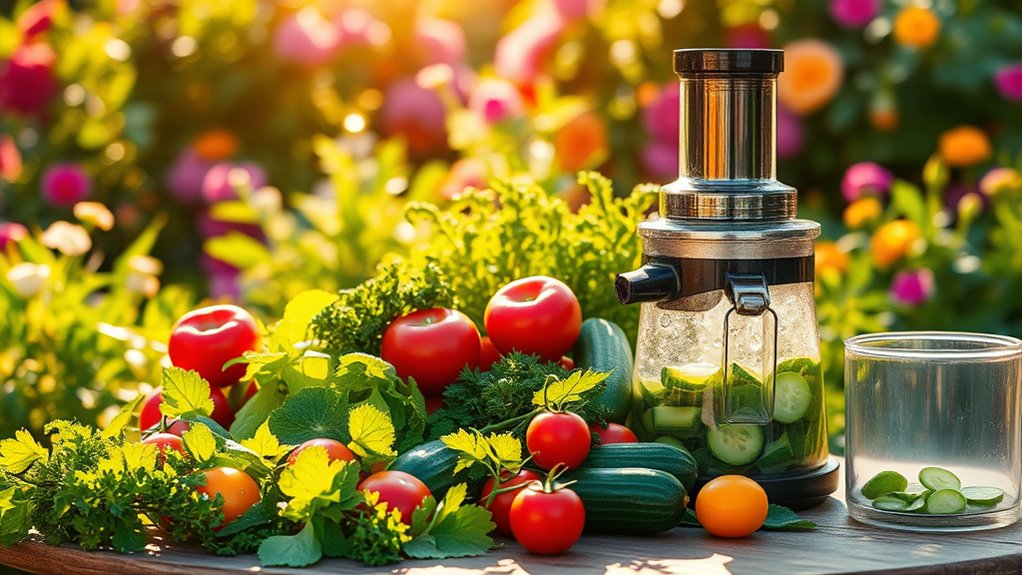
Growing your own fruits and vegetables can transform your juicing experience while saving you money. Instead of buying fresh produce, you can cultivate your favorite juicing ingredients like tomatoes, cucumbers, and mint right in your backyard or balcony.
This not only cuts grocery costs—saving families up to $600 annually—but also guarantees you’re getting the best juicing options available, as homegrown produce is fresher and more nutrient-dense.
Starting a garden requires minimal investment, with seeds costing as little as $1 to $3 per packet. Plus, incorporating composting can enhance your soil quality and create a sustainable cycle.
Sustainable Juicing Practices

While enjoying your favorite juices, you can also embrace sustainable practices that benefit both your health and the environment.
Embrace sustainable juicing practices that nourish your body and protect the planet.
Here are some tips to help you maximize your juicing experience:
- Buy seasonal and local produce – It supports your community and cuts down on transportation costs, making it more economical.
- Grow your own herbs – This not only saves money but also guarantees fresh flavors for your juices.
- Utilize scraps – Use leftover fruit and vegetable scraps like apple cores to reduce waste and maximize ingredient usage.
- Plan your juices – By preparing ahead, you’ll buy only what you need, minimizing waste and saving money.
These sustainable practices will enhance your juicing journey while being kind to your wallet and the planet!
Frequently Asked Questions
What Is the 80/20 Rule for Juicing?
The 80/20 rule for juicing suggests you should use 80% vegetables and 20% fruits in your juice mixes. This balance helps you reduce sugar intake while maximizing nutrients.
By focusing on leafy greens, cucumbers, and celery, you’ll create healthier juices that support better digestion and overall well-being.
Plus, since vegetables are usually cheaper than fruits, you can save money while enjoying delicious, nutrient-rich beverages.
It’s a smart choice for your health!
Does Juicing Really Improve Health?
Yes, juicing can definitely improve your health. It offers a concentrated source of vitamins and minerals, helping you boost your nutrient intake.
Regularly consuming fresh juices can aid digestion and enhance nutrient absorption. You’ll find that juicing supports detoxification, leading to increased energy and better mental clarity.
Plus, it can assist with weight loss by providing low-calorie, nutrient-dense options that help regulate your appetite while keeping you hydrated.
How Can I Save Money by Juicing?
Juicing can feel like a treasure hunt, and you can strike gold by being smart about it.
Buy seasonal fruits and veggies in bulk, and you’ll fill your cart without emptying your wallet. Use leftovers to boost your juice volume, and plan ahead to avoid impulse buys.
Check out the discount produce section—those blemishes won’t affect your juice. Growing your own herbs adds fresh flavor and saves you cash.
Enjoy your flavorful journey!
What Should You Not Mix When Juicing?
When juicing, avoid mixing high-sugar fruits like bananas and mangoes with leafy greens to prevent insulin spikes.
Don’t combine citrus fruits with dairy or high-protein foods, as this can lead to digestive issues.
Steer clear of mixing cruciferous vegetables with fruits, which might cause gas and bloating.
Finally, keep sweet and acidic fruits separate to avoid stomach upset.
Following these guidelines will help you create better-tasting and more digestible juices.
Conclusion
By embracing these budget-friendly juicing tips, you can nourish your body and your bank account. Savor the seasonal splendor of local produce, and stretch your spending with savvy shopping strategies. Use every scrap and sip every drop for delightful drinks that don’t break the bank. So, start juicing smarter today! Your wallet and wellness will thank you as you blend bold, beautiful beverages, making each glass a guilt-free gem of goodness.
Cindy thoroughly researches juicing trends, techniques, and recipes to provide readers with practical advice and inspiration. Her writing style is accessible, engaging, and designed to make complex concepts easy to understand. Cindy’s dedication to promoting the advantages of juicing shines through her work, empowering readers to make positive changes in their lives through the simple act of juicing.




